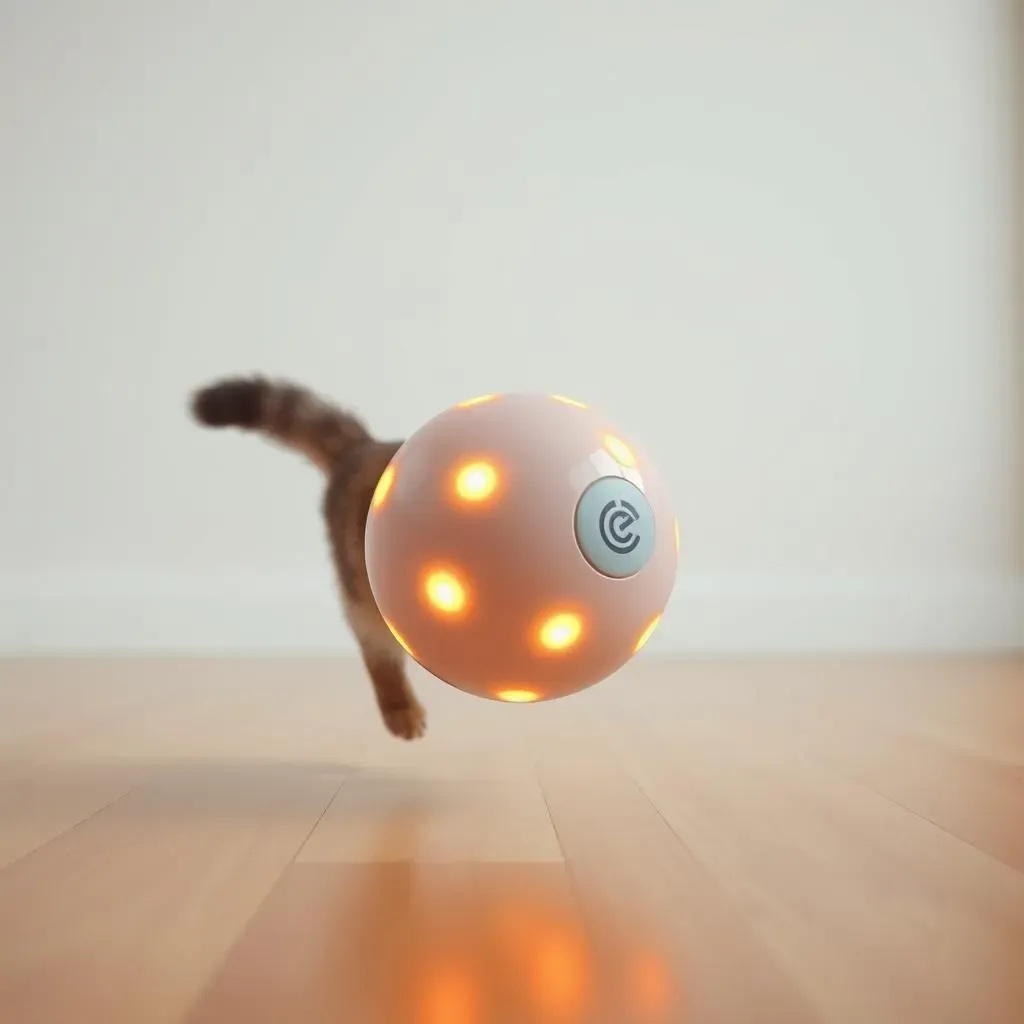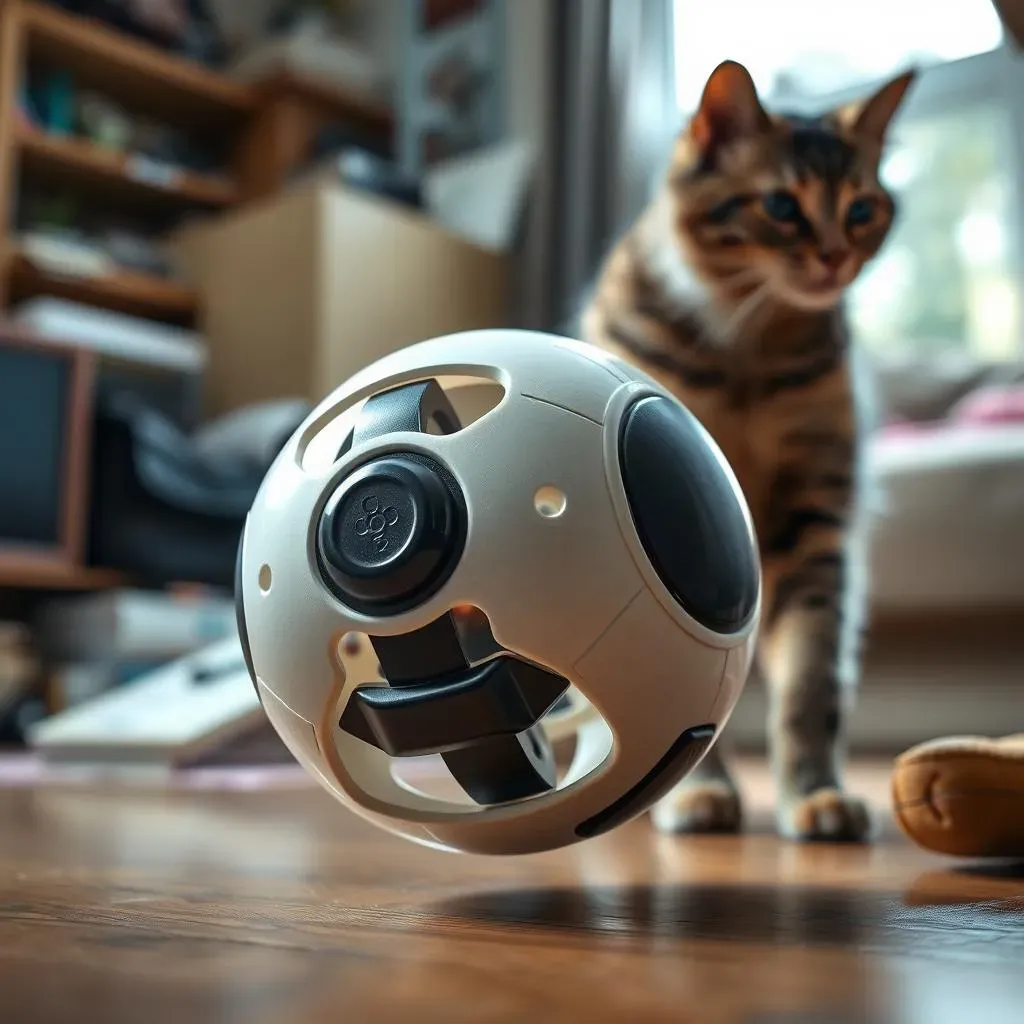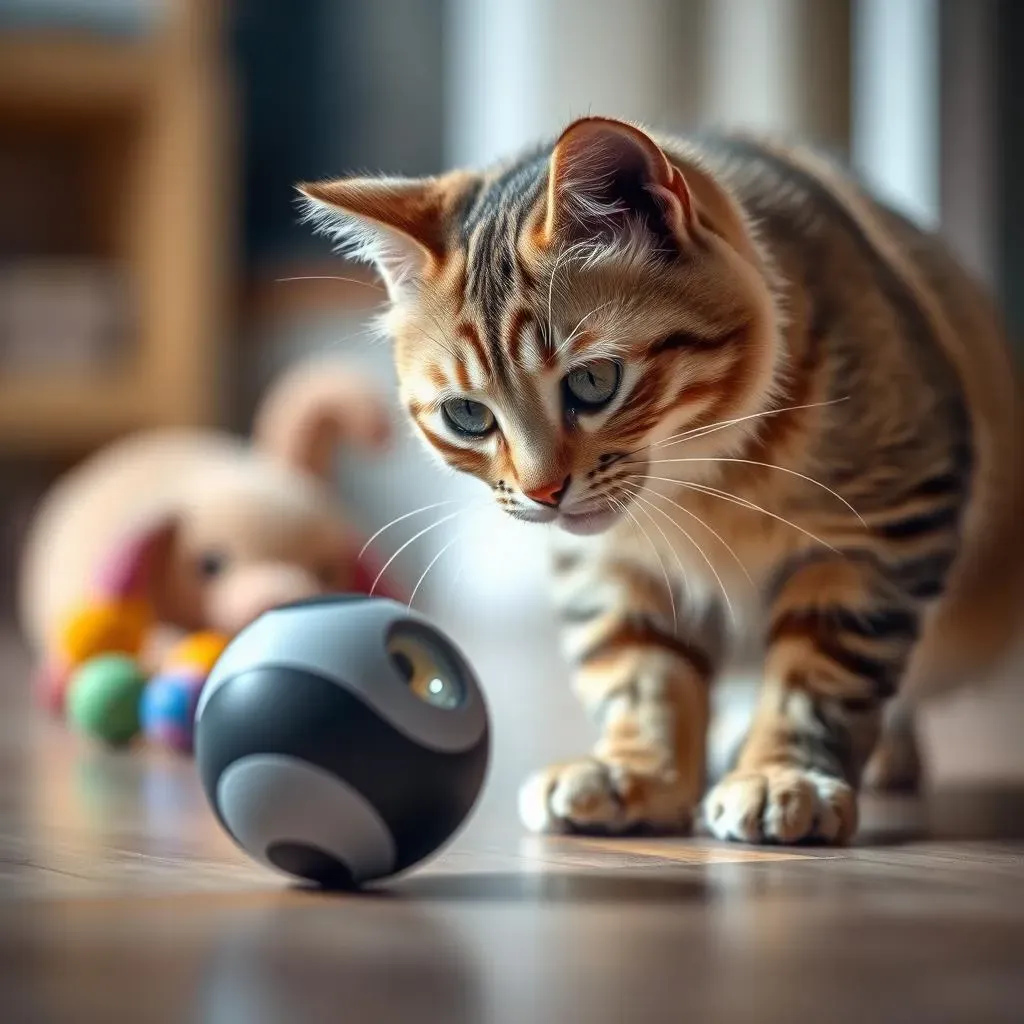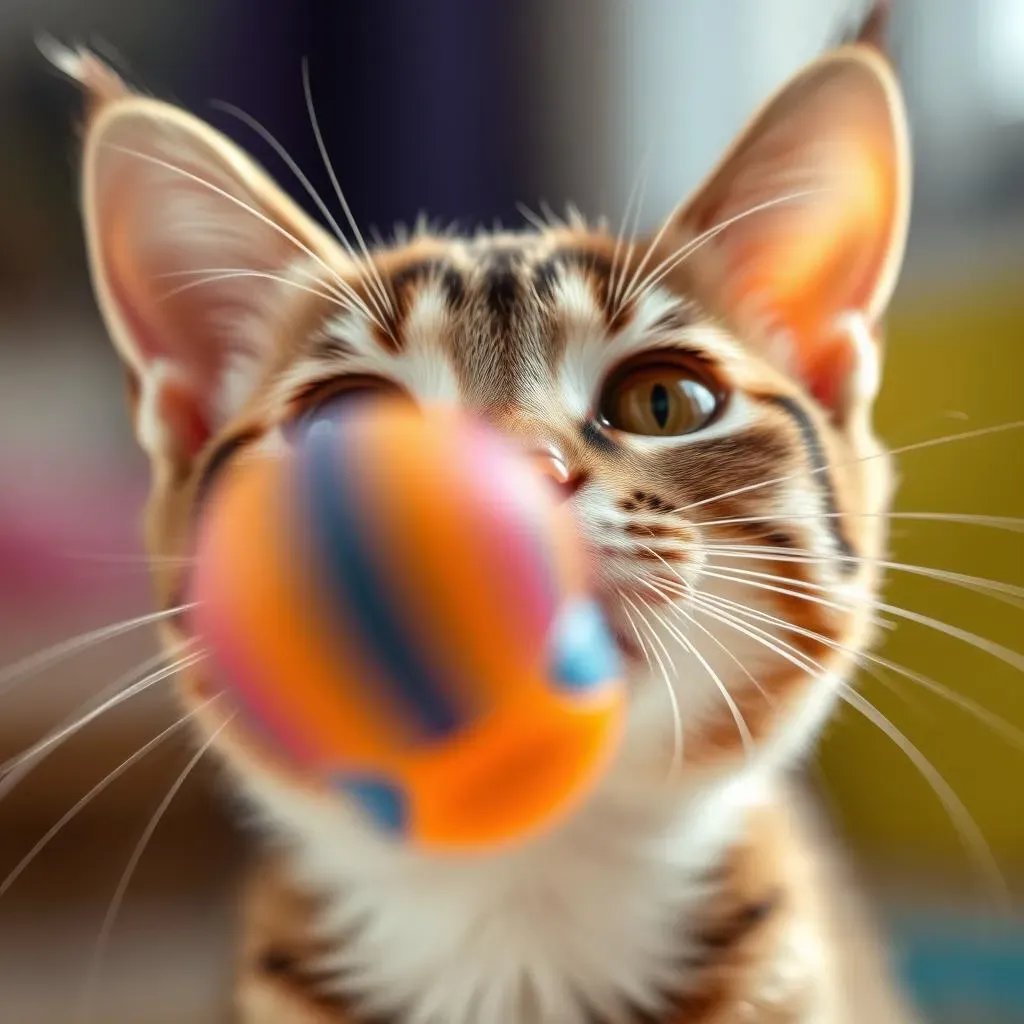Table of Contents
Ever watched your cat stare blankly at a wall, a tiny hunter trapped in a world of boredom? I know I have! It's like they're thinking, "Is this it? Is this all the excitement life has to offer?" That's where the magic of a moving cat toy ball comes in. Forget those static, snooze-inducing toys. We're talking about a dynamic, unpredictable, and downright entertaining way to unleash your cat's inner predator. This article is your guide to understanding why these toys are a game-changer, how to pick the perfect one, and, most importantly, how to make sure your feline overlord actually uses it. From choosing the right ball that fits your cat's play style to making the introduction a smooth one, we've got you covered. Let's turn that couch potato into a playful panther, shall we?
Why Your Cat Needs a Moving Toy Ball

Why Your Cat Needs a Moving Toy Ball
The Boredom Buster
Let's face it, our feline friends are magnificent creatures, but they can also be masters of the art of doing absolutely nothing. They sleep, they groom, they maybe glare at you from a high shelf. A moving cat toy ball is a simple solution to break the monotony. It's like a tiny, unpredictable prey item that activates their hunting instincts. Think of it as a way to bring the outside world, with all its exciting chases, right into your living room. It's not just about entertainment; it's about keeping them mentally stimulated and physically active.
A bored cat is not a happy cat, it can lead to unwanted behaviors like scratching furniture, excessive meowing, or even over-grooming. A moving toy ball provides a healthy outlet for that pent-up energy, helping to keep your cat content and your sanity intact.
Unlocking the Inner Hunter
Cats are natural hunters; it's in their DNA. Even the most pampered indoor cat still has those instincts lurking beneath the surface. A moving cat toy ball taps into this, mimicking the erratic movements of prey. The unpredictable rolling, bouncing, and sometimes even vibrating, keeps them engaged and curious. It's not just a toy; it's a challenge, a puzzle for them to figure out. It's like giving them a tiny, mobile mouse to stalk, chase, and pounce on, without any actual mice involved (thank goodness for that!).
It provides a safe and stimulating outlet for their predatory urges, keeping them happy and healthy. I remember when I first got my cat, she would just stare at the wall all day. Once I introduced the moving ball, it was like she had a new purpose in life! It was amazing to see her transform from a sleepy loaf to an agile hunter.
Benefit | Description |
|---|---|
Mental Stimulation | Keeps cats engaged and curious, preventing boredom. |
Physical Exercise | Encourages activity and helps maintain a healthy weight. |
Behavioral Improvement | Reduces unwanted behaviors associated with boredom. |
Safe Hunting Outlet | Satisfies predatory instincts in a safe, indoor environment. |
Health and Well-being
Beyond the fun and games, a moving cat toy ball plays a crucial role in your cat's overall health. Regular physical activity is key to preventing obesity and related health issues. A toy ball encourages them to move, jump, and chase, providing much-needed exercise. It's not about forcing them to work out; it's about making exercise fun and engaging. Plus, a mentally stimulated cat is often a happier and more well-adjusted cat, which is always a win-win for everyone involved.
It's amazing how much a simple toy can contribute to their well-being. It is a great way to make sure your cat is getting the physical and mental stimulation they need to thrive, and it’s a way to make their life better and more enjoyable.
Choosing the Right Moving Cat Toy Ball

Choosing the Right Moving Cat Toy Ball
Material Matters
Okay, so you're sold on the idea of a moving cat toy ball, but now you're staring at a wall of options. First things first, let's talk materials. You'll find balls made of plastic, rubber, fabric, and even some with a fuzzy exterior. Plastic is durable and easy to clean, but it can be noisy on hard floors. Rubber is a good choice for bouncing and grip, but some cats might chew on it. Fabric and fuzzy balls are softer and quieter, but they might not roll as predictably. Think about your cat’s preferences. Do they like to chew? Do they prefer soft surfaces? I always tend to go for a mix of materials, just to keep things interesting.
Also consider the size of the ball. It should be big enough that your cat can’t swallow it, but also small enough for them to bat around easily. A ball that’s too large might be intimidating, while one that’s too small could get lost under the furniture. And don't forget about safety! Make sure there are no small parts that could come off and be ingested. It's like picking a pair of shoes, you want them to fit just right and be safe for action!
Features to Consider
Now, let's get to the fun part: the features! Some moving cat toy balls are simple and rely on your cat's interaction to move, while others are motorized and move on their own. The motorized ones often have different modes, like random movement, bouncing, or even vibrating. Some even have built-in lasers or feathers attached for extra enticement. I've seen some that even change direction when they hit an obstacle, which is pretty cool. It’s all about keeping your cat guessing and engaged.
Consider your cat’s energy level and play style. A more energetic cat might prefer a faster-moving, more unpredictable ball, while a lazier cat might be happy with a slow-rolling or vibrating one. Also think about your living space. Do you have a lot of open space, or is it more cluttered? A ball that moves erratically might be a better choice for a larger space, while a more predictable ball is better for a small space. It’s like picking the right tool for the job, you want to make sure it fits the situation.
Feature | Description | Consideration |
|---|---|---|
Material | Plastic, rubber, fabric, fuzzy | Durability, noise, cat's preferences |
Size | Small enough to bat, large enough not to swallow | Cat's size, safety |
Movement | Self-propelled or interactive | Cat's energy level, play style |
Features | Laser, feathers, vibration | Additional entertainment |
How to Introduce a Moving Cat Toy Ball to Your Cat

How to Introduce a Moving Cat Toy Ball to Your Cat
The Gradual Approach
Okay, so you've got the perfect moving cat toy ball, but don't just throw it at your cat and expect them to go wild. That's a recipe for feline confusion, or worse, a complete lack of interest. Instead, think slow and steady. Start by letting your cat just sniff and investigate the new toy while it’s stationary. Put it on the floor and see if they approach it on their own. Maybe even give them a treat nearby to create positive associations. The goal here is to make the ball seem non-threatening and interesting. It's like introducing a new friend, you want to take it slow and let them get acquainted naturally.
Once your cat seems comfortable, try gently nudging the ball to make it move a little. Don't force it; just give it a little tap and see how they react. If they show interest, great! If not, just try again later. It’s all about patience and observation. Pay attention to your cat’s body language. Are their ears forward? Are they watching the ball intently? Or are they simply ignoring you and the shiny new thing? Your cat’s reaction will tell you how to proceed. Remember, every cat is different, so what works for one might not work for another.
Positive Reinforcement
Now, let's talk about the secret sauce: positive reinforcement. When your cat interacts with the moving cat toy ball, even if it's just a little bat or sniff, shower them with praise and maybe a small treat. This creates a positive association with the toy, which will make them more likely to play with it in the future. It’s like training a dog, but with more subtle cues and maybe a little more sass. Don't force play, though. Keep the sessions short and sweet, especially at first. It’s better to have a few minutes of enthusiastic play than a long session where your cat loses interest. And always end the play session on a positive note, when they’re still engaged and having fun. That way, they’ll be looking forward to the next playtime.
Also, try to vary the play sessions. Sometimes, let the ball move on its own, other times, you can control it. Use a wand or a string to make the ball move erratically, or even hide it under a blanket for your cat to discover. This variation will keep things interesting and prevent your cat from getting bored. I once had a cat that would only play with the ball if I made it "run away" from her, it was hilarious to watch, but it worked. This is all about learning your cat’s quirks and using them to your advantage.
Step | Description | Tip |
|---|---|---|
Initial Introduction | Let cat sniff stationary ball | Place ball on floor, offer treats nearby |
Gentle Movement | Nudge ball gently, observe reaction | Don't force play, watch cat's body language |
Positive Reinforcement | Praise and treats for interaction | Keep sessions short, end on a high note |
Vary Play | Change movement, add obstacles | Keep things interesting and engaging |
Maximizing Playtime with a Moving Cat Toy Ball

Maximizing Playtime with a Moving Cat Toy Ball
Changing the Game
Alright, so you've got your cat playing with the moving cat toy ball. Now how do we keep the fun going? It's not just about letting them chase the ball mindlessly. Think about adding some variety to keep them engaged. Try using different surfaces. A hard floor will make the ball move faster and more erratically, while a carpet will slow it down, making it more challenging to catch. You can also add obstacles like boxes or tunnels to make the game more interesting. It's like creating a little obstacle course for your feline athlete. This keeps their mind sharp and their body active. I like to switch it up every few days, it's like a new adventure every time.
Another trick is to change the time of day. Some cats are more active in the morning, while others are night owls. Experiment to find out when your cat is most playful and schedule playtime accordingly. Also, don’t just leave the ball out all the time. Keep it as a special toy that comes out during playtime. This will make it more exciting and less likely to be ignored. It's all about making playtime a special event, not just a routine.
Interactive Fun
While the moving cat toy ball is great for independent play, don't underestimate the power of interactive play. Get in on the action! Use a wand or string to make the ball move in unpredictable ways, or hide it under a blanket for your cat to discover. This not only makes the game more challenging but also strengthens the bond between you and your furry friend. It’s like a team sport, you’re working together to create an engaging experience. I love to see the look in my cat's eyes when she finally pounces on the ball after a good chase, it's pure joy.
And don't forget to rotate toys! Cats get bored easily, so having a variety of toys available will keep them engaged. Don’t just stick to the ball, mix it up with feather wands, toy mice, or even a crinkly paper bag. The key is to keep them guessing and keep the play sessions fun and exciting. It’s like having a full arsenal of toys at your disposal, ready to unleash the inner kitten in your cat. Remember, a happy cat is an active cat, and an active cat is a happy cat. It's a win-win situation for everyone.
Tip | Description |
|---|---|
Vary Surfaces | Play on hard floors, carpets, and other textures |
Add Obstacles | Use boxes, tunnels, and other objects to create challenges |
Change Timing | Play when your cat is most active |
Interactive Play | Use wands and strings to control the ball |
Toy Rotation | Switch toys regularly to prevent boredom |